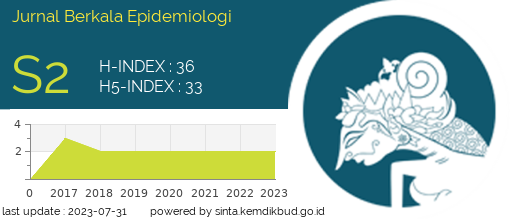Electronic Cigarette using in Surabaya's Personal Vaporizer Community
Downloads
At present, the number of electronic cigarette users has increased. Electronic cigarette users in 2010-2011 in Indonesia reached 0.5%. This study aims to describe the use of electronic cigarettes in the Surabaya Personal Vaporizer Community. This type of research is a descriptive observational study with a cross-sectional design. This research was conducted on 31 members of the Surabaya Personal Vaporizer Community. The dependent variable in this study is the use of electronic cigarettes, while the independent variables are knowledge, affordability, and family factors. The results showed that most electronic cigarette users aged 26 - 35 years (54.8%), were male (96.8%), had a high school education up to college (100%), worked as an employee (71%), had a history of smoking (93.6%), and reasoned as an effort to stop smoking (80.6%). The analysis by calculating the prevalence ratio shows that good knowledge about electronic cigarettes (PR = 0.89) and no family support (PR = 0.95) is a protective factor for not using electronic cigarettes, while the affordability of costs for electronic cigarette liquids is risk factors for using electronic cigarettes (PR = 1.32). Of all the variables studied, only the affordability of costs for electronic cigarette liquids is a risk factor for heavy electronic cigarette use. Therefore, education about the dangers of electronic cigarettes as well as the intended use of electronic cigarettes must continue and supervision of electronic cigarette use needs to be done.
Adkison SE., O'Connor RJ., Bansal-Travers M., Hyland A., Borland R., dan Yong HH. 2013. Electronic nicotine delivery system : International tobacco control four – country survey. Am J Prev Med. 44 (3): 207–215.
Bam TS., Bollow W., Berezhnova I., Jackson-Moris A., Jones A., dan Latif E. 2014. Position statement on electronic cigarette or electronic nicotine delivery systems. Int J Tuberc Lung Dis. 18 (1): 5–7.
Cobb NK., Byron MJ., Abrams DB., dan Shields PG. 2010. Novel Nicotine Delivery System and Public Health: The Rise of "E-cigarette”. Am J Public Health. 12: 2340–2342.
Dawkins L., Turner J., Roberts A., dan Soar K. 2013. ‘Vaping' profile and preferences : an online survey of electronic cigarette users. Addiction. 108 (6): 1115–1125.
Damayanti, A., 2015. Factor yang mempengaruhi penggunaan electronic cigarette pada Komunitas Personal Vaporizer Surabaya. Skripsi. Surabaya, Universitas Airlangga.
Dockrell M., Morison R., Bauld L., dan McNeill A. 2013. E-cigarette: prevalence and attitudes in Great Britain. Nicotine Tob Res. 15 (10): 1737–1744.
Electronic Cigarette Association. 2009. The facts about Electronic Cigarette. Washington.
Etter JF. 2010. Electronic Cigarette: A Survey of Users. BMC J Public Health. 10: 231.
Grana R., Benowitz N., dan Glantz SA. 2014. E-Cigarette: A Scientific Review. CIRCULATIONAHA. 129 (9): 1972–1986.
Jessica KP., Paul LR., Annie L., Linda DC., Melissa BG., dan Noel TB. 2013. Adolescent Males' Awareness of and Willingness to Try Electronic Cigarette. Journal of Adolescent Health. 52: 144–150.
McQueen A., Tower S., dan Sumner W. 2011. Interview with "vapers”: implication for future research with electronic cigarettes. Nicotine Tob Res. 13: 860–867.
Notoatmodjo, S. 2007. Perilaku Kesehatan dan Ilmu Perilaku. Jakarta : PT. Rineka Cipta.
Notoatmodjo, S. 2010. Ilmu Perilaku Kesehatan. Jakarta : PT. Rineka Cipta.
Paavola M., Vartiainen E., dan Haukkala A. 2004. Smoking From Adolescene to Adulthood, The Effect of Parental and Own Socioeconomic Status. European Journal of Public Health. 14(4): 417–420.
Pearson JL., Richardson A., Niaura RS., Vallone DM., dan Abrams DB. 2012. E-cigarette awareness, use and harm perceptions in US adults. Am J Public Health. 102 (9): 1758–1766.
Polosa, R., Rodu B., Caponnetto P., Maglia M., dan Raciti C. 2013. A fresh look attobacco harm reduction: the case for the electronic cigarette. Harm Reduction Journal. 10 (19): 1–11.
Regan AK., Promoff G., Dube SR., dan Arrazola R. 2013. Electronic Nicotine Delivery System: Adult use and awareness of the ‘e-cigarette' in the USA. Tob Control. 22 (1): 19–23.
Kementrian Kesehatan. 2013. Riset Kesehatan Dasar (RISKESDAS) Laporan Nasional 2013. http://www.litbang.depkes.go.id/sites/download/ rkd2013/Laporan_Riskesdas2013.PDF riskesdas 2013. (Sitasi tanggal 11 April 2015)
U.S. Food and Drug Administration (FDA). 2011. Flavored Tobacco. http://www.fda.gov/ TobaccoProducts/ProtectingKidsfromTobacco/ FlavoredTobacco/default.htm. (Sitasi 12 Juli 2015).
William M., Trtchounian A, dan Talbot P. 2010. Conventional and electronic cigarette (e-cigarette) have different smoking characteristics. Nicotine Tobacco Res. 12: 905–912.
WHO (World Health Organization). 2009. Report on the global tobacco epidemic.
WHO (World Health Organization). 2013. Media Centre: Fact Sheets of Tobacco. http://www.who.int/mediacentre/factsheets/fs339/en/. (Sitasi 18 Agustus 2015).
Zhu SH., Yun JY., Bonnevie E., Cummins SE., Gamst A., dan Yin L. 2014. Four hundredand sixty brands of e-cigarette and counting : implications for product regulation. Tob Control. 23: 33–39.
- Every manuscript submitted to must observe the policy and terms set by the Jurnal Berkala Epidemiologi
- Publication rights to manuscript content published by the Jurnal Berkala Epidemiologi is owned by the journal with the consent and approval of the author(s) concerned. (download copyright agreement)
- Complete texts of electronically published manuscripts can be accessed free of charge if used for educational and research purposes according to copyright regulations.

JBE by Universitas Airlangga is licensed under a Creative Commons Attribution-ShareAlike 4.0 International License.























